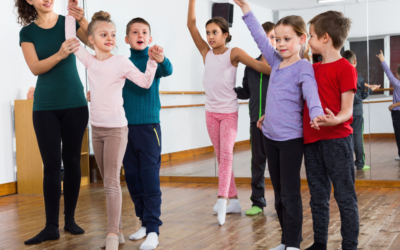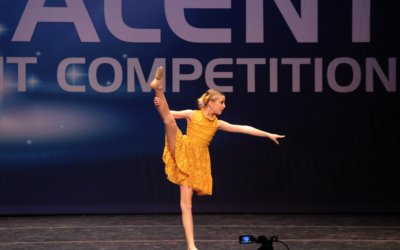Find Out Who Dances First at a Wedding Reception
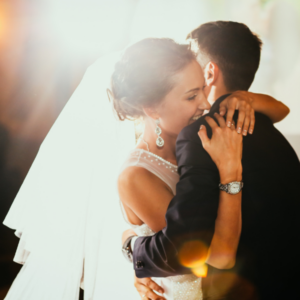 Our team breaks down the proper order of who dances first at a wedding in this helpful guide. In this article, we discuss:
Our team breaks down the proper order of who dances first at a wedding in this helpful guide. In this article, we discuss:
- The origin of the first dance
- The exact order of who dances first at a wedding reception
- How to plan out the order of dances at your wedding
Dancing is one of the most popular wedding reception activities, and each wedding dance has special meaning for the parties and partners involved. There are a number of different traditional wedding dances that can be included as part of your reception timeline. Using a wedding dance schedule is a great way to ensure there’s never a dull moment at your reception, giving guests ample time to eat, drink, dance, and mingle.
Whether you’re working with a wedding planner or are creating a wedding-day timeline by yourself, it’s important to know the proper order of who dances first at a wedding so you can be sure everything runs smoothly during your big day. Read on to find out the exact order of who dances first during a traditional wedding reception.
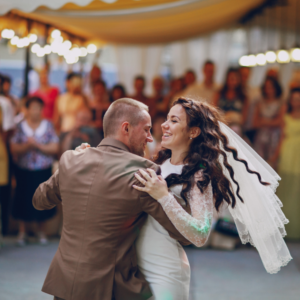 The Origin of the First Dance
The Origin of the First Dance
Before we dive into who dances first at a wedding, you might be interested to learn exactly where the first dance tradition originates. During 17th-century Europe when formal balls were most popular, it was customary for the guest of honor to lead the first dance. According to tradition, the first dance was a way for the host or hostess to announce the opening of the ball to their guests.
Since its 17th-century origins, the first dance has evolved to take many forms. In fact, if you attended a wedding 100 years ago, the first dance would have been led by the wedding guests and not the bride and groom as is typically done today. While there are no set “rules” regarding the structure of who dances first at a wedding, it’s a good idea to use this wedding day pastime as a way to structure your event and keep the party going strong.
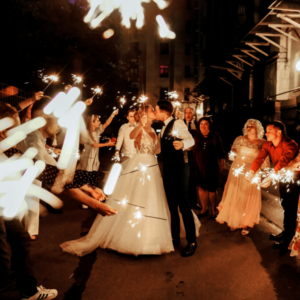 The Exact Order of Who Dances First at a Wedding Reception
The Exact Order of Who Dances First at a Wedding Reception
1. Grand Entrance
This isn’t typically considered a formal “dance,” but the grand entrance often sets the tone for the entire reception. After cocktail hour ends, members of the wedding party — including bridesmaids, groomsmen, best man, maid of honor, matron of honor, bridesmen, groomsladies, flower girls, ring bearers, and parents of the newlyweds — will gather and line up in pairs.
When the wedding guests have taken their seats in the reception hall, the DJ or emcee will begin playing the song of your choice and announce your wedding party by name as they enter the room. Rather than taking their seats, the party members will usually form a circle around the dance floor as they wait for the newlyweds to make the final entrance.
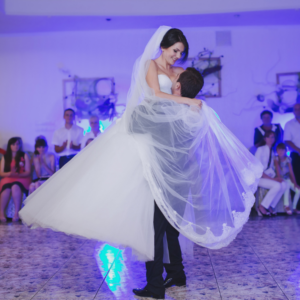 2. First Dance
2. First Dance
Once the newlyweds have made their grand entrance, it’s customary for them to begin their first dance. In some cases, however, newlyweds may opt to save their first dance for after their guests have eaten.
The first dance signifies the first steps together as a married couple. Some couples choose to take wedding dance lessons, crafting a custom-choreographed routine that will wow their guests. Others choose to wing it with a few sweet and simple steps. Whatever you decide, this is a time for your guests to focus all their positive energy on your journey together as newlyweds.
3. The Hora
If you happen to be Jewish, the next in the wedding dance timeline should be The Hora. This lively circle dance is a Jewish wedding classic that usually follows the first dance to signify the start of the reception. In some instances, The Hora may start up after dinner to kick off the dancing portion of the event with a bang. During this dance, the newlyweds and their parents are lifted up on chairs and paraded around the dance floor while their guests dance in a circular line dance.
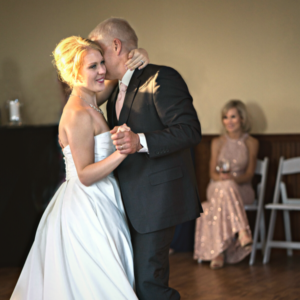 4. Parent Dances
4. Parent Dances
Next in line come the parent dances, such as the father-daughter or mother-son dance. The exact order of when these dances occur at a wedding really depend on your personal preference. In some cases, the father-daughter and mother-son dance happen right after the newlyweds’ first dance. For other couples, these dances might take place towards the end of dinner after the toasts or once the cake has been cut. Either way, the father-daughter dance usually comes first while the mother-son dance comes second.
5. Party Dances
Once the parent dances have finished, you may invite members of the wedding party to take to the dance floor. Typically, the best man and maid of honor dance together first, followed by the rest of the wedding party. Party dances are a great way to give the rest of your wedding guests a gentle push to get into the partying spirit — especially if you’re concerned about having a reception hall full of wall flowers.
6. Anniversary Dance
Also referred to as the bouquet dance, the anniversary dance is a sweet tradition that many couples choose to include in their wedding reception timeline. The dance works like this:
- All of the married couples in the room are invited to slow dance with their sweetheart.
- As the song plays, the DJ or emcee will interrupt occasionally, saying something like, “Couples who have been married for less than three years, take a seat.”
- The DJ continues to ask couples to sit down until the couple who has been married the longest is the only one left on the dance floor.
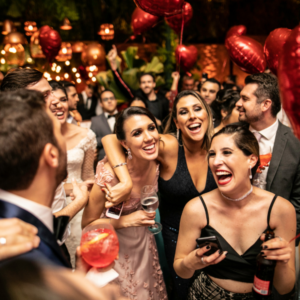 If you aren’t planning on having a bouquet toss, the longest-married couple will receive the bouquet. Otherwise, they get a round of applause and bragging rights to the other wedding guests for the rest of the evening.
If you aren’t planning on having a bouquet toss, the longest-married couple will receive the bouquet. Otherwise, they get a round of applause and bragging rights to the other wedding guests for the rest of the evening.
7. Open Floor
After the opening dances, your DJ will invite the rest of the guests onto the dance floor. This is when the real fun begins and your wedding day playlist is put to the test. A knowledgeable emcee will be able to read the room well enough to play a suitable mix of fast-paced beats and slow songs that will keep the party momentum going all night long.
8. Bouquet & Garter
The bouquet and garter toss dances are done one right after the other: One is done for the single ladies at the event while the other is for the single gentlemen. Here’s how it works:
- Bouquet Toss: During the bouquet toss, the bride will gather at the front of the dance floor, tossing her bouquet over her shoulder to her female wedding guests as they compete to catch it.
- Garter Toss: In this dance, the groom carefully removes his bride’s garter, gathering at the front of the dance floor to toss the garter behind his back to his male wedding guests.
Legend has it that whoever catches these items are next in line to be married. After the toss is complete, the two lucky winners will usually share a dance together.
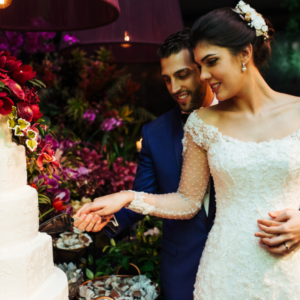 9. Post-cake Dance
9. Post-cake Dance
Wedding couples that choose to cut their cake later on in their reception might want to include another block of dancing dedicated to the cake cutting. This is a fun time for the younger guests at the wedding who still have energy to expend to once again take to the floor for another hour or two of dancing.
10. Money Dance
Known as the dollar dance or apron dance, the money dance is a long-held tradition that’s popular in many cultures. There are a few different ways that the money dance can be organized. For instance, wedding guests could “pay” for a dance with the couple. However the money dance is structured, the goal is the have the newlyweds showered in cash by the end of the reception.
11. Last Dance
What is chosen as the last dance largely depends on the tone you wish to set for your guests. If you don’t plan on having an afterparty, choosing a slower song that gets everyone in the mood to relax after a day of dancing and partying is a smart decision. Otherwise, get guests in gear to continue the party with an upbeat tune they can dance to on their way out the venue and on to the next party scene.
Plan Out Your Wedding Day Dances with QC Dance Studio!
At QC Dance Studio, our in-house DJs and professional emcees have years of experience helping to craft the perfect wedding dance timeline for every couple we serve. Whether you’re looking to choreograph your first dance or are seeking a wedding reception venue near Charlotte, we are here to help. Request a private wedding dance lesson or book your tour of our reception venue by contacting us online today!

